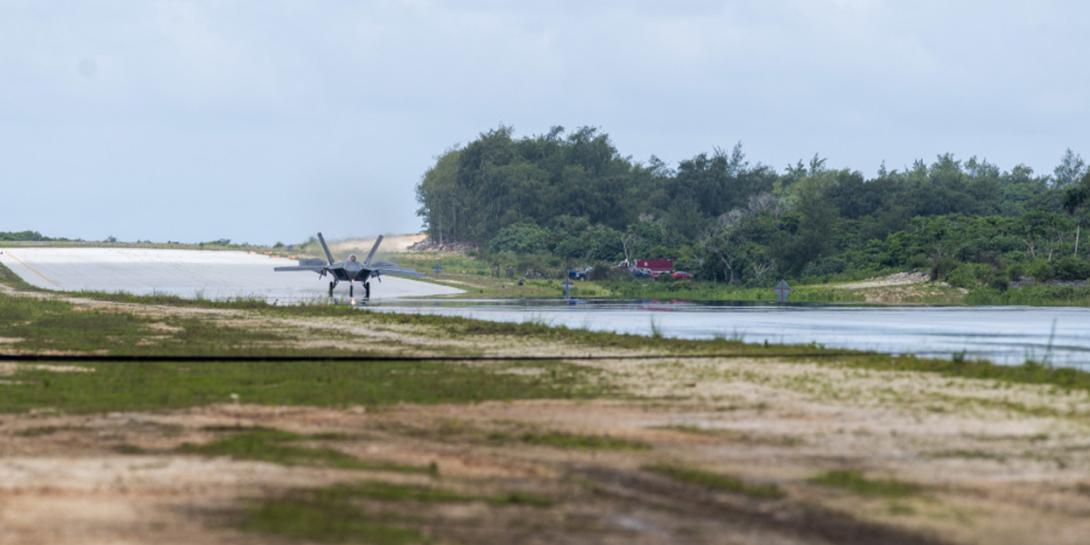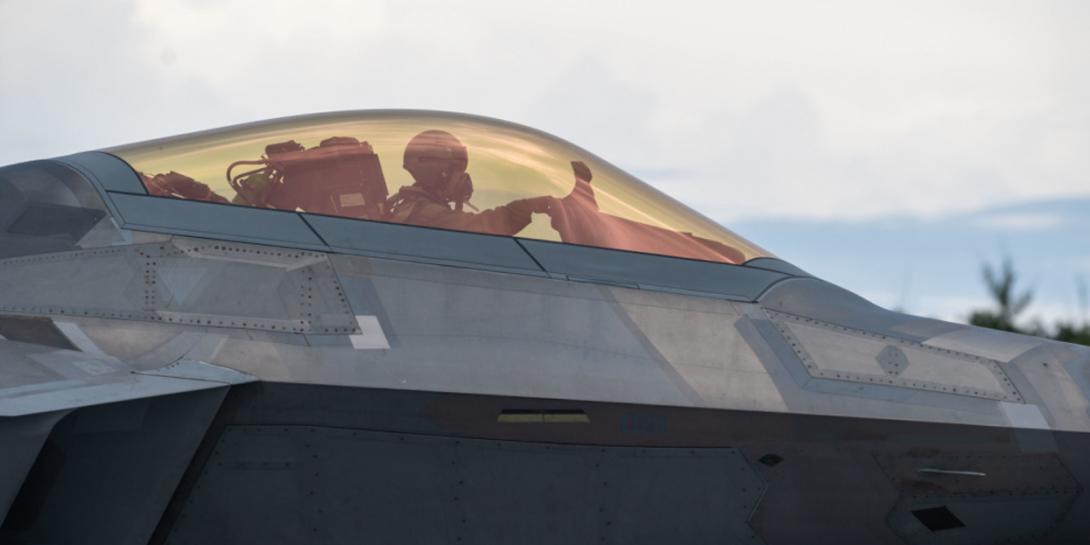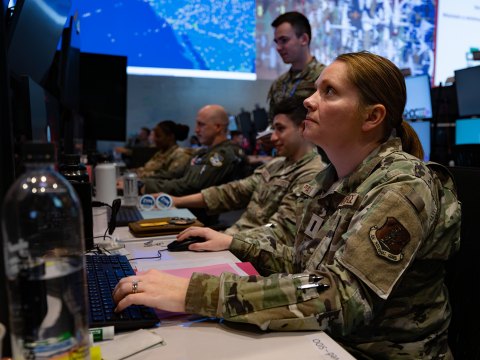Putting ACE to the Test
In preparation for a contested near-peer environment, the U.S. Air Force is working to send forces and assets to austere locations on short notice as part of its agile combat employment concept. The service’s ability to support the greater Joint Force’s dynamic force employment will provide a range of air-related military options and quickly deployed forces when needed in response to emerging requirements. To sharpen its skills in providing a more lean, agile and lethal force that can generate airpower from smaller and more dispersed locations in the Indo-Pacific Command’s area of responsibility, the service’s Pacific Air Forces, also known as PACAF, conducted Operation Pacific Iron 21 during the month of July, ending last Friday. About 800 airmen participated in the exercise.
“One of the things that was unique about this event is that we operated in several different locations and the scale of what we did was new, and it presented the opportunity for us to learn a lot of different things with agile combat employment,” said Lt. Col. Brant “Skills” Reilly, USAF, PACAF Agile Combat Employment (ACE) lead, Operation Pacific Iron 21, and F-35 Lightning II pilot. “We operated in multiple locations here on the island of Guam and then we also worked out at Tinian as well. Operating on multiple islands at the same time obviously creates logistics and communication challenges but that is what we worked through. And so, one of the biggest takeaways was our ability to operate in multiple locations at one time.”
Amongst other capabilities, the exercise tested the multi-capable airmen’s abilities in performing refueling and maintenance across several locations, to support the 35 aircraft deployed from Air Combat Command and PACAF, which included approximately 10 F-15E Strike Eagles; 25 F-22 Raptors; and two C-130J Hercules. The ACE warfighters conducted simulated combat flight missions from three locations on Guam: Andersen Air Force Base, Antonio B. Won Pat International Airport, and Northwest Field, which was once a World War II airfield, as well as from Tinian International Airport, Tinian.
“Why this was such a success is that we didn't lose, to my knowledge, any flying because of lack of fuel or because we were unable to execute the logistics supply chain required for maintenance,” Col. Reilly said.
During the operation, the Pacific Air Forces also continued its priority of building partnerships across the region. The ability to generate airpower from nontraditional base locations requires the permission of partner nations and trust of U.S. operations, explained Lt. Col. Michael “Papa” Roche, USAF, lead, Dynamic Force Employment Planning and Operational, Operation Pacific Iron 2021.
“One of the big lessons learned, which we have with any dynamic force employment, and is what we do when we put forces in unfamiliar places, is to build the relationships around the world, and for this specific operation, the Indo-Pacific Region,” the A-10 pilot said. “Every time we do something like this, we learn that it strengthens those relationships. And it helps us promote the free and open Indo-Pacific area of which we are a part, and we want to be part of that team.”
Naturally, the airmen moving around to these unfamiliar locations have to gain the additional skills necessary to successfully support and achieve combat employment operations. “When we send a pilot to let's say Tinian or to North Westfield, these are places that we don't normally fly. So, we'll have to put operational forces out there,” Col. Roche said. “It's something that we don't do all the time, so it just introduces all those problems, and now we all have to solve them, and it just makes us better.”
Fighter pilots, too, are branching out a bit from their traditional roles, Col. Reilly added.
“We are operating in a new and different way, and everyone is just learning so much, it makes it interesting to be a part of,” he said. “From a fighter pilot perspective, [it is] being prepared to do more things that are outside my normal lane. In the community, we are starting to look more closely at being able to turn our own jets and refuel. I also need to be prepared to land on shorter runways that I'm used to potentially, so that requires more focused training in that area.”
Col. Reilly noted that learning how to perform agile combat employment does put a heavier burden on mid-level leadership. “Because we are operating in so many different locations now we're depending on younger NCOs [non-commissioned officers] and officers to be in charge at these locations and take on the possibility of generating the forces required to execute the mission,” he emphasized. And for the most part, the fighter pilot said, “I think people are excited to contribute to different areas that are outside of their normal lane.”
To address any environmental concerns on Guam and Tinian, the service worked closely with the Tinian government and the Commonwealth of Northern Mariana Islands (CNMI) government. For example, the airmen had to meet bio-environmental considerations in washing down of aircraft and vehicles, and they developed a secondary containment system.
“[Tinian] is such a small island and we're a large force coming in with a lot of jets, and we had fuel trucks and fire trucks,” Col. Roche explained. “The Brown Tree Snake also is a concern, bringing it from Guam, so you have to be very careful with that. We coordinated with the authorities on Tinian and in the CNMI to make sure everything was taken care of with inspections. We had to make sure we were meeting the requirements of all the countries and we had to come up with solutions to problems on the spot, and that goes toward the multi-capable airmen. You only have a small footprint out there, and maybe it's not their specialty, but they've got to come up with the solution. It all just helps people learn how to problem solve.”
In addition to assistance from Marine Corps’ TPS-80 radar capabilities, F-18 Super Hornets, and Navy EA-18G Growler aircraft, the Air Force’s Air Combat Command brought in a wing from Mountain Home Air Force Base, Idaho, and support from Kadena Air Base, Japan, to help with integrated combat turn operations and provide to communications, as well as to improve their own agile combat employment skills. The warfighters were able to harness ultra-high frequency (UHF) and very high frequency (VHF) capabilities, as well as access secret and non-classified networks during the operation, said Capt. Austin Sewell, USAF, maintenance officer and camp commander, 389th Expeditionary Fighter Squadron.
“The 644th Combat Communications (Combat Comm) Squadron and the 6th Communications troops forward deployed with us to Tinian were instrumental in ensuring that we had uninterrupted communication with our team on Guam,” he shared. “They provided us with UHF, VHF, SIPRNet and NIPRNet capabilities in a compact package that was able to be deployed and redeployed rapidly. Their expertise and ability to troubleshoot issues on the fly provided us reliable communication throughout the operation.”
The ability of the communications team to “seamlessly integrate” with the 366th Fighter Wing was crucial to their success, Capt. Sewell continued. “Several multi-capable communications airmen even volunteered to augment the maintainers, ultimately manning the forklift to position some of our cargo in preparation for our redeployment,” he said. “I could not be happier with the team and Combat Comm’s willingness to support this agile operation.”
Before the exercise, austere locations, such as in Tinian, had no communications set up for Air Force and DOD networks. “And it worked,” Col. Roche stated. “People were accessing the unclassified and classified networks. Sometimes it's just a challenge accessing your work computer at your desk so, seeing it working out in the austere locations for me, that is what I'm looking for. That's the result.”
The command and control node operation center that supplied the communications and intelligence information to the Pacific Iron participants represented a contested environment.
“It gave us the opportunity to compare some of the communications equipment the units were using to support agile combat employment,” Col. Reilly noted. “We were able to gain some lessons testing different pathways of communications and comparing between the two from the different commands. If something doesn't work, we have an alternative communication pathway to use.”
Col. Roche confirmed that working with the Marines and the Navy added another level of experience in using the warfighter concepts. “This was just a tremendous opportunity to go out and work inter-service relationships and become that kind of symbiotic team,” he said. “There is a lot of good feedback from the opportunities that this dynamic force employment provided.”
As the service advances its dynamic abilities, agile combat employment will become commonplace, Col. Reilly concluded.
“Based on the National Defense Strategy, we needed to come up with new ways of operating,” he stated. “With agile combat employment, it is teaching us how to operate differently, especially when it comes to logistics and communication. And to be honest, if we should ever have to go into a conflict and have to employ this for real, we’ll be ready. I think it has also given us a lot of benefits for peacetime too. We are becoming more effective in the way that we are using our personnel, with concepts like multi-capable airmen. It's pushing the envelope forward in developing more resilient communication systems.
“And as we progress into the future, you are going to hear less about something being broadcast as an agile combat employment event or exercise, because it's just going to be the way we operate and the normal procedures that we will be using on a daily basis,” said Col. Reilly.






Comments